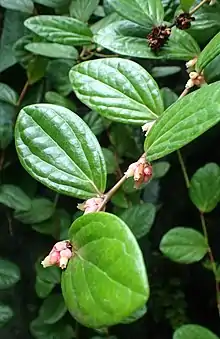| Anthopterus wardii | |
|---|---|
 | |
| Scientific classification | |
| Kingdom: | Plantae |
| Clade: | Tracheophytes |
| Clade: | Angiosperms |
| Clade: | Eudicots |
| Clade: | Asterids |
| Order: | Ericales |
| Family: | Ericaceae |
| Genus: | Anthopterus |
| Species: | A. wardii |
| Binomial name | |
| Anthopterus wardii Ball | |
Anthopterus wardii, the aengue mishito, is a species of Anthopterus belonging to the family Ericaceae. It is native to the tropical regions of Central and South America, such as Panama, Colombia, and Ecuador.[1]
Description
Anthopterus wardii is a flowering shrub with flowers ranging from pink to orange in color and 8–10 mm long. Its leaves are elliptic to ovate-elliptic and 4–10 x 1.5–3.5 cm in size.[2] Its racemose usually have 2–10 flowers.
Health benefits
Anthopterus wardii has possible health benefits based on its antioxidant properties and phenolic profile.[3] This can be the precursor for many compounds with health benefits including, antibacterial, anti-inflammatory, and antimutagenic activities.[4] It is possible that the antioxidants can help prevent heart disease.[5]
References
- ↑ "Anthopterus wardii Family: Ericaceae Neotropical Blueberry". Top Tropicals. Retrieved 23 August 2021.
- ↑ "Anthopterus wardii Ball, Hooker". New York Botanical Garden. Retrieved 23 August 2021.
- ↑ Keyvan Dastmalchi; Gema Flores; Vanya Petrova; Paola Pedraza-Penaloza; Edward J. Kenelly (2011). "Edible Neotropical Blueberries: Antioxidant and Compositional Fingerprint Analysis". J Agric Food Chem. US National Library of Medicine National Institutes of Health. 59 (7): 3020–3026. doi:10.1021/jf200367j. PMC 3389551. PMID 21391608.
- ↑ "Phenolic Compound". ScienceDirect. Retrieved 23 August 2021.
- ↑ "'Super' blueberries from South America". United Press International. 14 July 2011. Retrieved 23 August 2021.